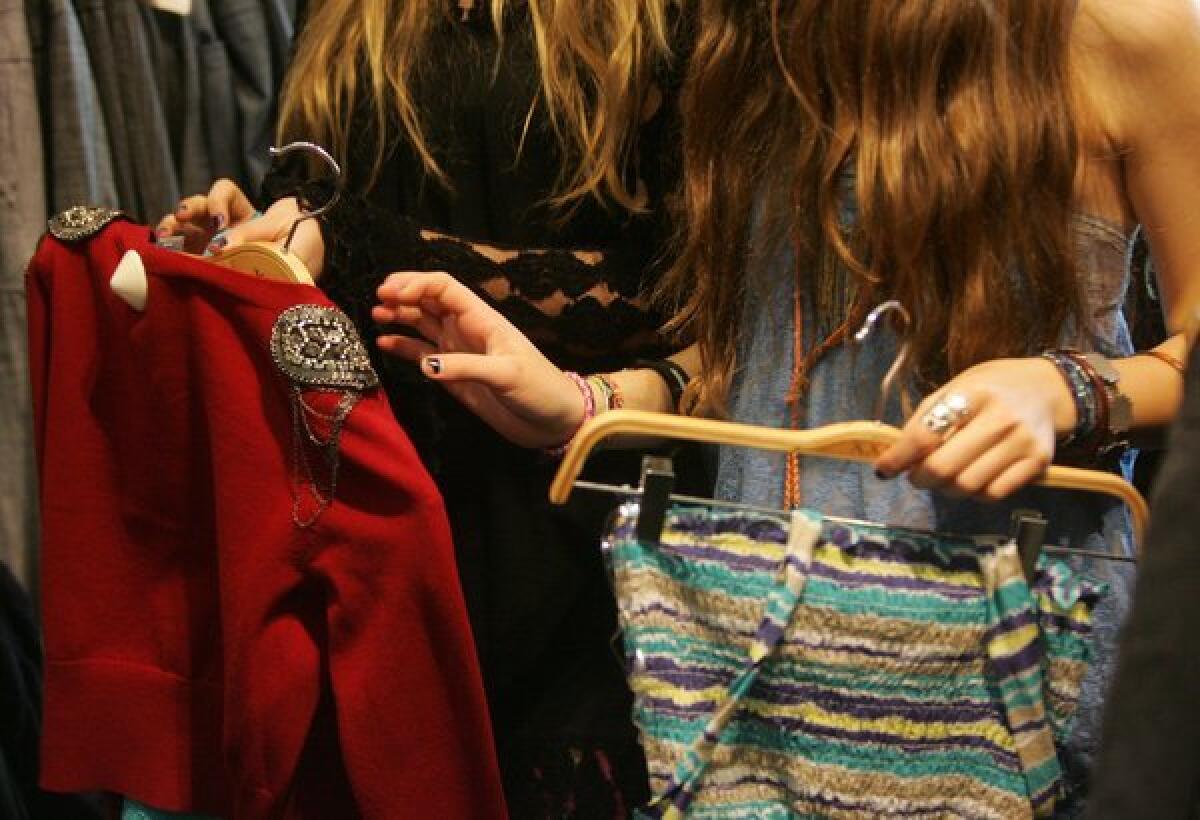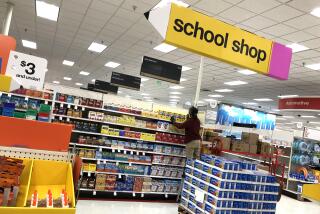For mall stores, back-to-school shopping can’t come soon enough
The $84-billion back-to-school shopping season is back just in time as far as beleaguered mall merchants are concerned.
Consumer spending on kids and young adults returning to the classroom not only is the second-largest shopping period behind the winter holidays, but it’s one when many conventional physical stores are holding their own against the surge of online competition.
Although the growth of e-commerce has forced dozens of U.S. retail chains to close thousands of locations at malls and elsewhere, analysts said that children and their parents still like visiting stores to purchase items on their back-to-school lists — notebooks and lunch boxes and clothes and computers.
“This is one category where we’re seeing a surprising level of support for the in-store experience,” said Jim Mills, who heads the Southern California consumer business practice for Deloitte, the consulting and auditing firm.
Back-to-school shoppers plan to do most of their buying in physical stores, according to a survey conducted for the National Retail Federation by Prosper Insights & Analytics.
Online shopping came in third, tied with clothing stores, when consumers were asked to name all the places they were planning to do their buying. Nearly 46% of those surveyed said they would do some online shopping, almost unchanged from a year ago but up about 10 percentage points from 2015, showing the strong growth of e-commerce.
In a separate survey, the International Council of Shopping Centers trade group found “that 68% of shoppers said they don’t envision buying all of their school supplies online,” spokeswoman Stephanie Cegielski said.
“People still want to see and touch and interact with products,” she said.

Retailers increasingly are making it easier for consumers to order products online and then have them delivered to their homes or pick them up at the store. The latter option often prompts shoppers to stroll elsewhere in the store to buy other merchandise or — in the case of Wal-Mart Stores Inc. and Target Corp., for instance — pick up groceries as well.
For many youngsters and their parents, the store visits are as important as the convenience of e-commerce. It’s one thing for kids to give their parents a holiday wish list and hope for the best, and quite another for kids to demand a select type of notebook, backpack or apparel after they’ve looked them over in person, analysts said.
“They’re online a lot, don’t get me wrong,” NRF spokeswoman Ana Serafin Smith said. “But they’re using online more to do research than to actually pull the trigger and buy.”
The NRF’s research also is showing that youths age 20 and under are “really interested in bringing the brick-and-mortar experience back” for buying back-to-school items, Serafin Smith said. “They love going into the stores and shopping the way their grandparents did.”
In contrast to back-to-school shopping, the winter holidays find parents often prefer to shop without their children. The NRF’s 2016 holiday shopping survey reflected that, with online shopping outpacing every other store category: About 52% of shoppers planned to buy online; the No. 2 category was department stores at 42%.

Back-to-school sales, including those for young adults returning to college, are expected to climb a stout 10.3% this year to $83.6 billion from $75.8 billion, the NRF estimates, citing stronger employment, higher consumer confidence about the economy and lower gasoline prices.
The Conference Board, a business trade group, last week said its consumer confidence index rose in July to its highest level since mid-2001.
“This is good news for retailers, arriving just as the back-to-school retail sales season is beginning to heat up,” said Chris Christopher Jr., executive director for economics at the research firm IHS Markit.
“Our forecast calls for growth of 4.3% in back-to-school retail sales this year compared to last year, which would be the strongest growth since 2014,” Christopher said.
The portion of back-to-school sales for kids in elementary school through high school is forecast at $29.5 billion, and the portion for college students is $54.1 billion, the NRF said.
College sales include a variety of merchandise that’s of less or no value to the even-younger set, including items for dorm rooms, such as bedding and mini-refrigerators, and branded collegiate apparel and other goods.
Computers and other electronics top the list for college students, with the NRF finding that they’ll spend $12.8 billion on electronics, followed by $8 billion for clothing.
Beyond the immediate sales it generates, the back-to-school season is crucial for retailers because it “remains an important bellwether for what is to come over the holidays” in terms of consumers’ willingness to spend, Christopher said.
Every year, it’s two days before the start of school and I’m in Staples buying school supplies.
— Stephanie Cegielski, International Council of Shopping Centers
Mills said the back-to-school season is a key marketing tool for retailers because the level of their service, prices and convenience will determine whether customers return in four months for the Christmas season.
“They’re focused on this season being a great platform to expose to the consumer what they can offer,” Mills said.
That exposure starts with dedicated back-to-school sections in stores and online. Amazon’s “Back to School Checklist” link sits at the top of its homepage; Staples Inc.’s “Back to School Center” link also tops its website.
Wal-Mart’s website allows schools to post checklists of their required supplies so that students and parents can immediately order them with a few clicks. In its physical stores, the giant retailer also has “back-to-school helpers” to direct customers to the merchandise they’re looking for and the shortest checkout lines.
RetailMeNot.com, a website that connects shoppers with retailers, said its survey of back-to-school buying habits found that “nearly one in three consumers (28%) always search for items online before going in the store.” But 54% said they end up doing most of their shopping in a physical store.
When it comes to choosing which stores to patronize, the same problems plaguing certain types of retailers show up in back-to-school shopping as well.
Deloitte found that mass merchants such as Wal-Mart and Target not only are the most popular destinations, with 73% of parents saying they planned to shop at such stores, but the percentage rose sharply from a year ago.
Conversely, parents’ preference for traditional department stores — which would include Macy’s Inc. and J.C. Penney Co. — fell from a year earlier to 34%. Their preference for specialty clothing stores also fell, to 9%.
“You’re seeing a shift to more discount-related stores, away from the traditional department stores,” said the ICSC’s Cegielski. Although consumer confidence is up, “people are being much more price conscious,” she said.
Cegielski said another reason people still visit physical stores is the need to make last-minute purchases, and she confessed she is in that group.
“Every year, it’s two days before the start of school and I’m in Staples buying school supplies,” she said. “You’re almost forced to visit a brick-and-mortar store rather than waiting for a shipment from online because it’s too late.”
Twitter: @PeltzLATimes
ALSO
How cosigning a mortgage loan can bring big risks
Uber and Lyft are outpacing taxis among business travelers
Airlines with good passenger experiences have highest stock returns, study finds
More to Read
Inside the business of entertainment
The Wide Shot brings you news, analysis and insights on everything from streaming wars to production — and what it all means for the future.
You may occasionally receive promotional content from the Los Angeles Times.











